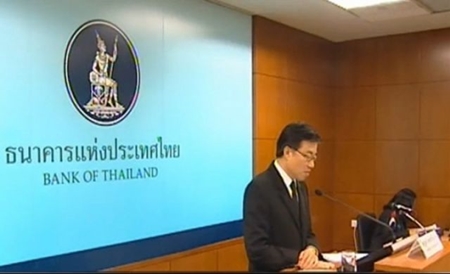BANGKOK, Oct 26 – An earlier forecast of Thailand’s gross domestic product (GDP) growth at 4.2 per cent this year was lowered for the fourth time to 3.7 per cent, according to the Bank of Thailand (BoT).
Paiboon Kittisrikangwan, BoT assistant governor for money policy, said the Monetary Policy Committee (MPC) reduced the the GDP growth projection in light of stagnant private consumption, less active stimulus from the public sector and inactive expansion of Thai exports.

Advanced technology was minimally used in manufacturing of Thai products and emphasis was given to production of hard-disk drives though production recently switched to smart phones and tablets, he said.
Production of smart phones and tablets has yet to fully cash in on the economic revival among Thailand’s trading partners, he said, adding that export value increased by only 1 per cent from an earlier estimate of 4 per cent.
Mr Paiboon said the Thai economy should grow at a more satisfactory percentage of 4.8 – slightly lower than the original projection of 5 per cent – while exports should expand at 7 per cent.
He foresaw a higher trend of domestic consumption, from 2.6 per cent this year to 2.9 per cent next year, and spending for durable products would be back to normal in the second half of next year.
The country’s revenue and confidence would improve in accord with the global economy and exports, said the assistant governor who, however, expressed concern on lower-than-expected disbursement of national budget funds and investment capital.
Investment spending for infrastructure projects would be delayed by a quarter and it is estimated that only half the state budget would be spent in 2014-2015, he said.
Mr Paiboon said public spending under the Water Management Act would also make little progress, and disbursement would only cover urgent projects where as public referendum would be required for the government’s expenditure on long-term schemes.
The Thai economy will remain in U-shaped recession and volatile to various factors but it could roll up late this year until next year, said Mr Paiboon.
Some risk factors–including the state’s delayed investment on infrastructure projects, the US public debt and unclear decision on quantitative easing, uncertainty in global money market, volatile currency exchange and the balance of current account deficit– must be closely monitored, he said.
Imports of heavy machinery and capital goods under the infrastructure investment projects would lead to a US$7 billion deficit next year, he said.
This year’s US$6.8 billion deficit was mainly due to gold imports and auto companies’ transfers of profit to their mother’s companies abroad, said Mr Paiboon.
He said the country’s inflation would be low at 2.2 per cent this year and 2.4 per cent next year while the basic inflation for this year and next year are 1 per cent and 1.2 per cent respectively.




